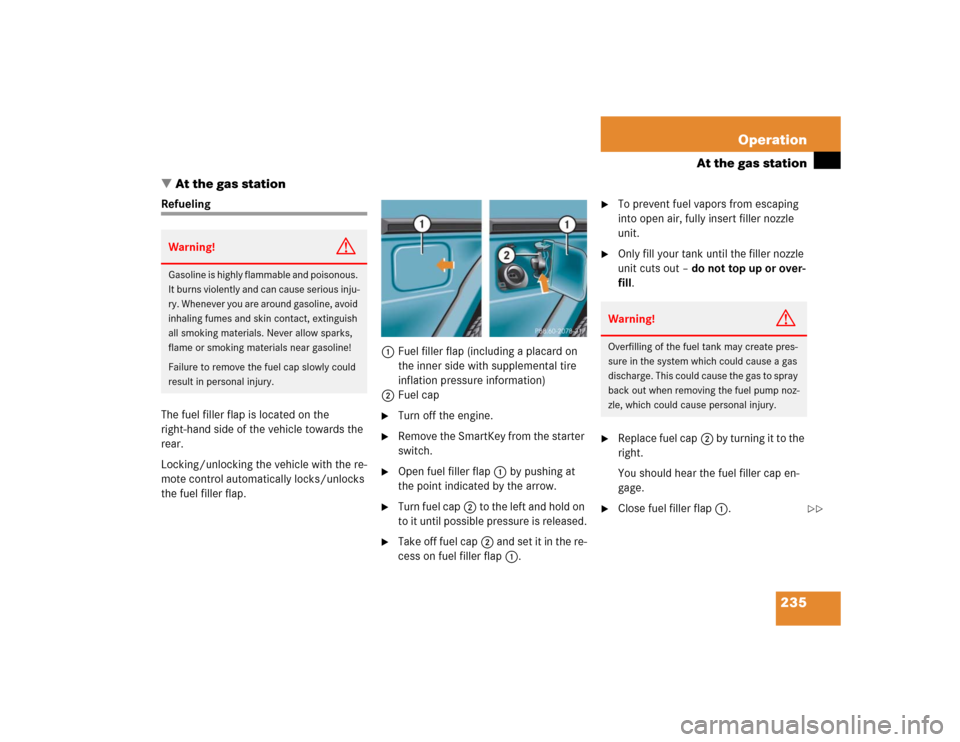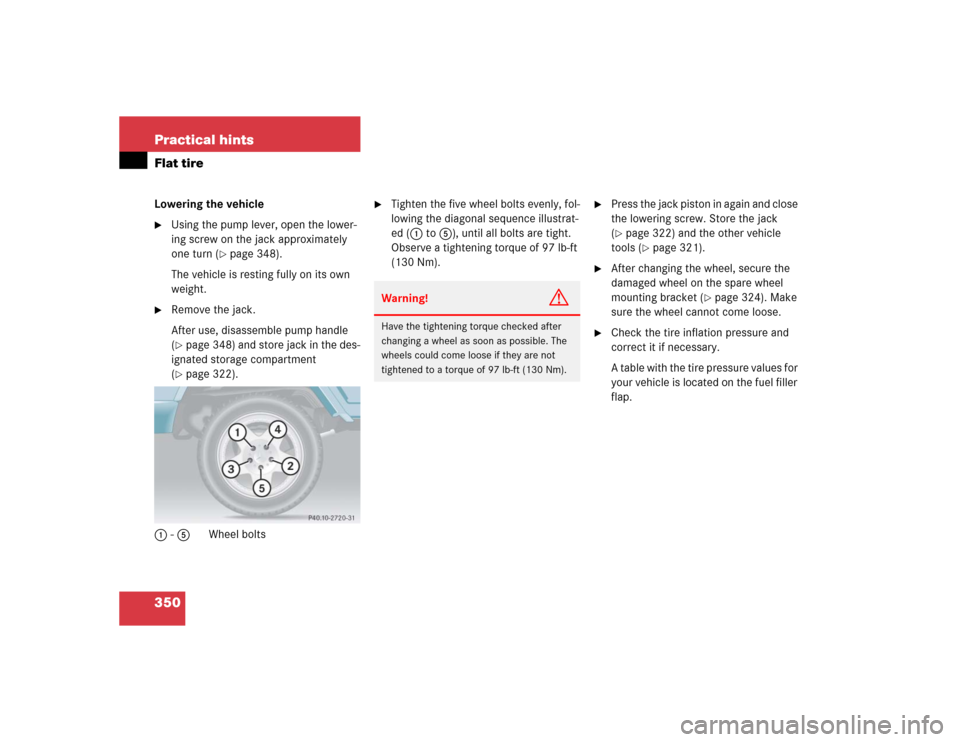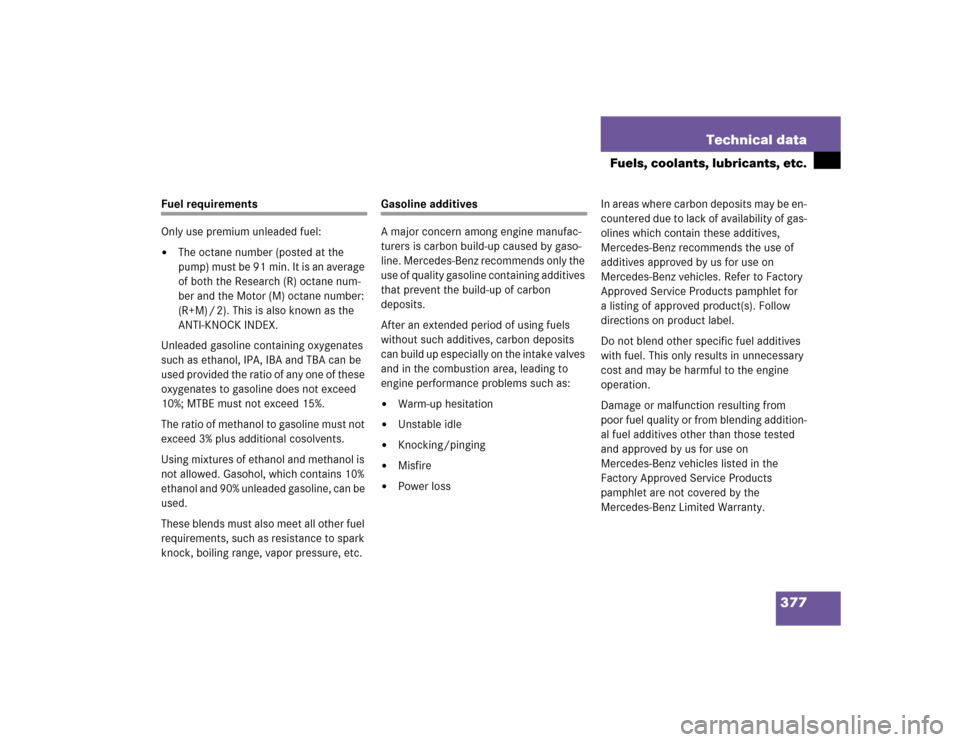Page 235 of 416

235 Operation
At the gas station
�At the gas station
Refueling
The fuel filler flap is located on the
right-hand side of the vehicle towards the
rear.
Locking/unlocking the vehicle with the re-
mote control automatically locks/unlocks
the fuel filler flap.1Fuel filler flap (including a placard on
the inner side with supplemental tire
inflation pressure information)
2Fuel cap
�
Turn off the engine.
�
Remove the SmartKey from the starter
switch.
�
Open fuel filler flap1 by pushing at
the point indicated by the arrow.
�
Turn fuel cap2 to the left and hold on
to it until possible pressure is released.
�
Take off fuel cap2 and set it in the re-
cess on fuel filler flap1.
�
To prevent fuel vapors from escaping
into open air, fully insert filler nozzle
unit.
�
Only fill your tank until the filler nozzle
unit cuts out – do not top up or over-
fill.
�
Replace fuel cap2 by turning it to the
right.
You should hear the fuel filler cap en-
gage.
�
Close fuel filler flap1.
Warning!
G
Gasoline is highly flammable and poisonous.
It burns violently and can cause serious inju-
ry. Whenever you are around gasoline, avoid
inhaling fumes and skin contact, extinguish
all smoking materials. Never allow sparks,
flame or smoking materials near gasoline!
Failure to remove the fuel cap slowly could
result in personal injury.
Warning!
G
Overfilling of the fuel tank may create pres-
sure in the system which could cause a gas
discharge. This could cause the gas to spray
back out when removing the fuel pump noz-
zle, which could cause personal injury.
��
Page 236 of 416
236 OperationAt the gas station
Check regularly and before a long tripG5001Coolant
2Brake fluid
!The fuel filler cap is tethered to the fuel
filler neck. Do not drop the cap. It could
damage the vehicle paint finish.
When refueling the vehicle, make cer-
tain that no gasoline comes into con-
tact with plastic tail lamp to prevent
damaging the lens.iUse only premium unleaded gasoline
with a minimum Posted Octane Rating
of 91 (average of 96 RON / 86 MON).
Information on gasoline quality can
normally be found on the fuel pump.
More information on gasoline can be
found in the Factory Approved Service
Products pamphlet.
iLeaving the engine running and the fuel
cap open can cause the ? malfunc-
tion indicator lamp (USA only) or the
± malfunction indicator lamp
(Canada only) to illuminate.
See also “Practical hints” section
(�page 292).
��
Page 350 of 416

350 Practical hintsFlat tireLowering the vehicle�
Using the pump lever, open the lower-
ing screw on the jack approximately
one turn (
�page 348).
The vehicle is resting fully on its own
weight.
�
Remove the jack.
After use, disassemble pump handle
(�page 348) and store jack in the des-
ignated storage compartment
(�page 322).
1-5 Wheel bolts
�
Tighten the five wheel bolts evenly, fol-
lowing the diagonal sequence illustrat-
ed (1 to 5), until all bolts are tight.
Observe a tightening torque of 97 lb-ft
(130 Nm).
�
Press the jack piston in again and close
the lowering screw. Store the jack
(�page 322) and the other vehicle
tools (
�page 321).
�
After changing the wheel, secure the
damaged wheel on the spare wheel
mounting bracket (
�page 324). Make
sure the wheel cannot come loose.
�
Check the tire inflation pressure and
correct it if necessary.
A table with the tire pressure values for
your vehicle is located on the fuel filler
flap.
Warning!
G
Have the tightening torque checked after
changing a wheel as soon as possible. The
wheels could come loose if they are not
tightened to a torque of 97 lb-ft (130 Nm).
Page 377 of 416

377 Technical data
Fuels, coolants, lubricants, etc.
Fuel requirements
Only use premium unleaded fuel:�
The octane number (posted at the
pump) must be 91 min. It is an average
of both the Research (R) octane num-
ber and the Motor (M) octane number:
(R+M) / 2). This is also known as the
ANTI-KNOCK INDEX.
Unleaded gasoline containing oxygenates
such as ethanol, IPA, IBA and TBA can be
used provided the ratio of any one of these
oxygenates to gasoline does not exceed
10%; MTBE must not exceed 15%.
The ratio of methanol to gasoline must not
exceed 3% plus additional cosolvents.
Using mixtures of ethanol and methanol is
not allowed. Gasohol, which contains 10%
ethanol and 90% unleaded gasoline, can be
used.
These blends must also meet all other fuel
requirements, such as resistance to spark
knock, boiling range, vapor pressure, etc.
Gasoline additives
A major concern among engine manufac-
turers is carbon build-up caused by gaso-
line. Mercedes-Benz recommends only the
use of quality gasoline containing additives
that prevent the build-up of carbon
deposits.
After an extended period of using fuels
without such additives, carbon deposits
can build up especially on the intake valves
and in the combustion area, leading to
engine performance problems such as:�
Warm-up hesitation
�
Unstable idle
�
Knocking/pinging
�
Misfire
�
Power lossIn areas where carbon deposits may be en-
countered due to lack of availability of gas-
olines which contain these additives,
Mercedes-Benz recommends the use of
additives approved by us for use on
Mercedes-Benz vehicles. Refer to Factory
Approved Service Products pamphlet for
a listing of approved product(s). Follow
directions on product label.
Do not blend other specific fuel additives
with fuel. This only results in unnecessary
cost and may be harmful to the engine
operation.
Damage or malfunction resulting from
poor fuel quality or from blending addition-
al fuel additives other than those tested
and approved by us for use on
Mercedes-Benz vehicles listed in the
Factory Approved Service Products
pamphlet are not covered by the
Mercedes-Benz Limited Warranty.